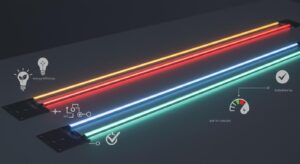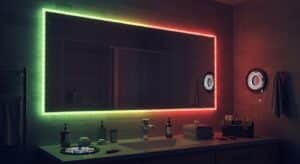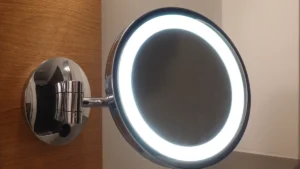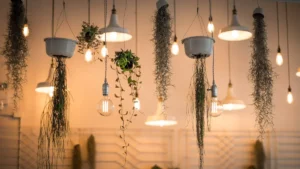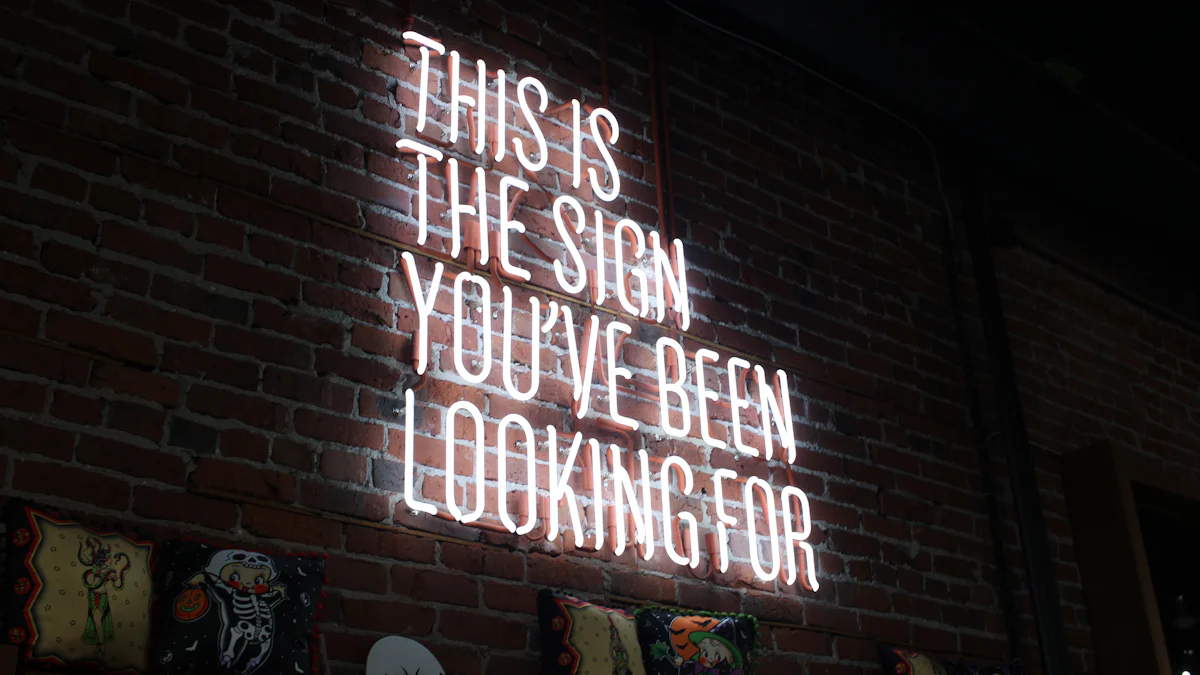
Imagine the thrill of crafting your own neon LED sign, a beacon of creativity and personal expression. With modern LED technology, you can easily create stunning neon-like signs without the need for intricate glassblowing or hazardous gases. These signs are not only safer and more durable but also accessible to everyone. Whether you want to add a touch of personality to your home or make a bold statement for your business, neon LED signs offer endless possibilities. Dive into the world of DIY neon LED projects and experience the joy of bringing your unique designs to life.
Understanding Neon LED Signs
What Are Neon LED Signs?
Neon LED signs are a modern twist on the classic neon signs. They use LED technology to mimic the vibrant glow of traditional neon. Unlike the old-school neon signs, which rely on glass tubes filled with gas, neon LED signs use flexible LED strips. This makes them safer and more versatile.
Differences Between Traditional Neon and LED
Traditional neon signs have been around for decades. They use glass tubes filled with neon gas to produce light. These signs are fragile and require careful handling. In contrast, LED signs use durable silicone tubes. They are less prone to breakage and much easier to install.
LED signs also consume significantly less energy. This means lower electricity bills for you. They are more environmentally friendly and require minimal maintenance. Traditional neon signs need regular upkeep to maintain their brightness. LED signs, however, maintain their vibrant glow with little effort.
Advantages of Using LED Technology
LED technology offers several benefits. First, it is energy-efficient. You save money on electricity while enjoying bright, eye-catching signs. Second, LED signs are long-lasting. They outlast traditional neon signs, reducing the need for replacements. Third, they are customizable. You can choose from a wide range of colors and designs to suit your needs.
Popular Uses for Custom Neon LED Signs
Neon LED signs are incredibly versatile. You can use them in various settings to add a touch of flair and personality.
Home Decor
In your home, neon LED signs can serve as unique decor pieces. They can brighten up a living room or add a fun element to a bedroom. You can create signs with your favorite quotes or symbols. They are perfect for personalizing your space.
Business Signage
For businesses, neon LED signs are a great way to attract customers. They are visible from a distance and can make your storefront stand out. You can customize them with your business name or logo. This helps in building brand recognition.
Event Decorations
Neon LED signs are also popular for events. Whether it’s a wedding, birthday party, or corporate event, these signs can enhance the atmosphere. You can create signs that match the theme of your event. They add a memorable touch that guests will love.
Materials and Tools Needed for Neon LED Signs
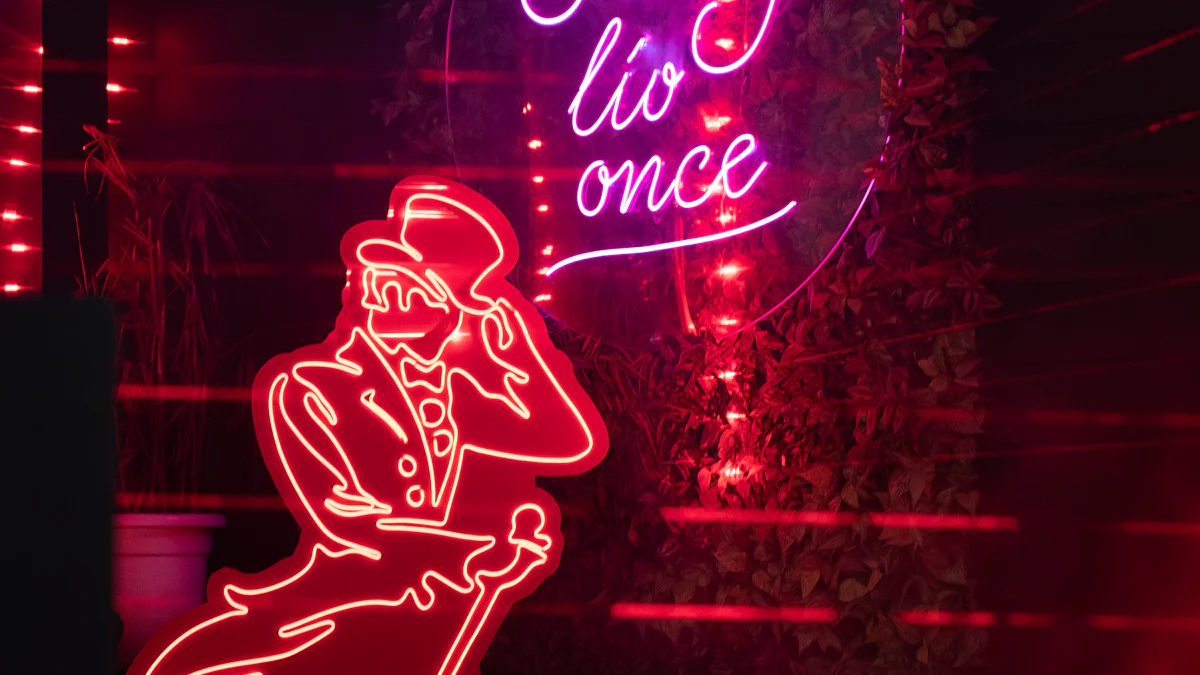
Creating your own neon LED sign requires gathering the right materials and tools. This section will guide you through the essentials you’ll need to bring your design to life.
Basic Materials
To start, you’ll need a few key materials. These form the backbone of your neon LED sign project.
LED Neon Flex Strip
The LED Neon Flex Strip is the heart of your sign. It mimics the look of traditional neon but offers greater flexibility and safety. These strips are available in various colors and lengths, allowing you to customize your sign to your liking. They are energy-efficient and provide a bright, consistent glow.
Power Supply and Adapter
A reliable Power Supply and Adapter is crucial. It ensures your neon LED sign lights up properly. Choose a power supply that matches the voltage requirements of your LED strip. This will prevent any electrical issues and keep your sign shining brightly.
Mounting Surface (e.g., acrylic board)
You’ll need a sturdy Mounting Surface to attach your LED strips. Common choices include clear acrylic boards, wood, or other rigid materials. Acrylic is popular due to its transparency and ease of use. It provides a clean, professional look for your sign.
Tools for the Job
Having the right tools makes the assembly process smoother and more efficient.
Cutting Tools
You’ll need Cutting Tools to shape your LED strips and mounting surface. A scroll saw or a sharp utility knife works well for cutting acrylic or wood. Precision is key, so take your time to ensure clean cuts.
Adhesives and Fasteners
To secure your LED strips to the mounting surface, use Adhesives and Fasteners. Hot glue is a common choice for its quick-drying properties. It holds the strips firmly in place. You might also consider using small screws or clips for added stability.
Optional: Soldering Kit for Advanced Users
For those looking to add a professional touch, a Soldering Kit can be useful. It allows you to make precise connections between LED strips. This is optional and recommended for advanced users who want to customize their signs further.
With these materials and tools, you’re well-equipped to start crafting your neon LED sign. Gather everything you need, and you’ll be ready to bring your creative vision to life.
Step-by-Step Guide for Beginners

Creating your own neon LED sign can be a fun and rewarding project. Whether you’re a beginner or have some experience, this guide will walk you through the process step by step. Let’s get started!
Designing Your Neon LED Sign
Before you dive into assembling your sign, you need a solid design plan. This stage is all about creativity and planning.
Sketching Your Design
Start by sketching your design on paper. Think about what you want your neon LED sign to say or depict. It could be a word, a phrase, or a simple shape. Use a pencil to outline your ideas, and don’t worry about making it perfect. This sketch will serve as a blueprint for your project.
Consider the space where you’ll display your sign. Measure the area to ensure your design fits well. A well-thought-out sketch will make the assembly process smoother.
Choosing Colors and Sizes
Next, decide on the colors and sizes for your neon LED sign. LED strips come in various colors, so choose ones that match your vision. You might want a single color for a classic look or multiple colors for something more vibrant.
Size matters too. Consider the thickness of the LED strips and how they will fit into your design. Thicker strips provide a bolder look, while thinner ones offer more flexibility for intricate designs.
Assembling the Sign
With your design ready, it’s time to bring it to life. Follow these steps to assemble your neon LED sign.
Cutting and Shaping the LED Strip
First, cut the LED strip to match your design. Use a sharp utility knife or scissors for clean cuts. Be precise and follow your sketch closely. If your design has curves, gently bend the strip to shape it. LED strips are flexible, making it easy to create smooth lines and curves.
Attaching the Strip to the Surface
Now, attach the LED strip to your mounting surface. Use hot glue or adhesive tape to secure it in place. Start from one end and work your way to the other, pressing the strip firmly as you go. Ensure the strip follows your design accurately. If needed, use small clips or screws for extra stability.
Connecting the Power Supply
Finally, connect the power supply to your neon LED sign. Follow the instructions provided with your LED strip kit. Typically, you’ll attach the power adapter to the end of the strip. Make sure the connections are secure to avoid any electrical issues. Once connected, plug in the power supply and watch your sign light up!
Creating a neon LED sign is a fantastic way to express your creativity. With these steps, you can craft a sign that reflects your style and personality. Enjoy the process and have fun experimenting with different designs and colors.
Intermediate Techniques for Neon LED Signs
Ready to take your neon LED sign skills to the next level? Let’s explore some intermediate techniques that will add functionality and depth to your creations. These methods will help you create signs that are not only visually stunning but also interactive and dynamic.
Adding Dimmer and Remote Control Features
Imagine having the ability to adjust the brightness of your neon LED sign with just a click. Adding dimmer and remote control features can enhance the versatility of your sign, making it suitable for various settings and moods.
Selecting Compatible Components
To start, you’ll need to choose components that work well with your existing setup. Look for dimmer switches and remote controls specifically designed for LED strips. These components should match the voltage and power requirements of your neon LED sign. Compatibility ensures smooth operation and prevents any technical issues.
Expert Testimony:
“As a business owner, you want to make sure your sign is visible to customers and potential customers. You also want it to be legible and visually appealing.”
This advice highlights the importance of selecting the right components to maintain the visual appeal of your sign.
Installation Process
Once you’ve gathered the necessary components, it’s time to install them. Follow these steps for a seamless setup:
Disconnect Power: Always start by unplugging your neon LED sign to ensure safety.
Connect Dimmer: Attach the dimmer switch between the power supply and the LED strip. Ensure all connections are secure.
Pair Remote Control: If your dimmer includes a remote, follow the manufacturer’s instructions to pair it with the dimmer switch.
Test Functionality: Reconnect the power and test the dimmer and remote control. Adjust the brightness to see the effect on your sign.
Adding these features not only enhances the functionality of your sign but also provides a modern touch that users will appreciate.
Creating Multi-Layered Designs
Want to add depth and dimension to your neon LED sign? Multi-layered designs can create a stunning visual effect that captures attention.
Planning the Layout
Start by planning your layout. Think about how different layers will interact and complement each other. Sketch your design, considering the placement of each layer. This step is crucial for achieving a cohesive look.
Base Layer: This is the foundation of your design. It should be bold and simple.
Middle Layer: Add elements that provide contrast and interest.
Top Layer: Use this layer for intricate details or highlights.
Layering Techniques
With your layout planned, it’s time to bring your multi-layered design to life. Here are some techniques to consider:
Use Different Colors: Different colors for each layer can create a striking effect.
Vary Thickness: Use LED strips of varying thickness to add depth.
Overlap Elements: Overlapping parts of your design can create a sense of movement and flow.
By experimenting with these techniques, you can craft a neon LED sign that stands out and showcases your creativity.
Advanced Methods for Experienced Crafters
As you become more skilled in crafting neon LED signs, you might want to explore advanced techniques. These methods will allow you to customize your signs further and integrate them with modern technology.
Customizing with Soldering
Soldering can elevate your neon LED sign projects by providing more precise connections and a professional finish. Before you start, it’s crucial to understand the safety measures and techniques involved.
Safety Precautions
Safety should always come first when working with soldering tools. Here are some essential precautions:
Wear Protective Gear: Always wear safety goggles and gloves to protect yourself from hot solder and fumes.
Work in a Ventilated Area: Ensure your workspace is well-ventilated to avoid inhaling harmful fumes.
Keep a Clean Workspace: A tidy area reduces the risk of accidents. Keep flammable materials away from your soldering station.
By following these precautions, you can safely enjoy the benefits of soldering in your projects.
Soldering Techniques for LED Strips
Once you’re ready, you can begin soldering your LED strips. Here’s a simple guide to get you started:
Prepare the Strips: Cut the LED strips to your desired length. Strip the ends of the wires to expose the metal.
Tin the Wires: Apply a small amount of solder to the exposed wire ends. This process, known as “tinning,” makes it easier to connect the wires.
Join the Wires: Align the tinned wires with the corresponding pads on the LED strip. Heat the joint with the soldering iron and apply solder until it flows smoothly over the connection.
Inspect the Connection: Check for any cold solder joints or excess solder. A good connection should be shiny and smooth.
Mastering these techniques will give your neon LED signs a polished look and ensure reliable performance.
Integrating Smart Home Technology
Incorporating smart home technology into your neon LED signs can add a futuristic touch. You can control your signs remotely and even integrate them with other smart devices.
Compatible Smart Devices
To get started, you’ll need to choose compatible smart devices. Look for:
Smart Plugs: These allow you to turn your neon LED sign on and off using a smartphone app or voice commands.
Smart Controllers: Devices like Wi-Fi-enabled LED controllers let you adjust brightness and colors remotely.
Ensure that the devices you select are compatible with your existing smart home ecosystem, whether it’s Amazon Alexa, Google Assistant, or another platform.
Setup and Configuration
Setting up your smart neon LED sign involves a few straightforward steps:
Connect the Smart Device: Plug your neon LED sign into the smart plug or controller.
Install the App: Download the app associated with your smart device. Follow the instructions to pair it with your sign.
Configure Settings: Use the app to set schedules, adjust brightness, and change colors. You can also integrate the sign with other smart devices for automated routines.
By integrating smart technology, you can enhance the functionality of your neon LED signs and enjoy the convenience of remote control.
Safety Tips and Considerations for Neon LED Signs
When crafting your neon LED sign, safety should always be a top priority. By following some essential guidelines, you can ensure a safe and enjoyable crafting experience.
Electrical Safety
Electricity powers your neon LED sign, so handling it with care is crucial. Here are some tips to keep in mind:
Handling Power Supplies
Power supplies are the backbone of your neon LED sign. You need to choose a power supply that matches the voltage requirements of your LED strips. This prevents overheating and potential damage. Always unplug the power supply before making any adjustments or connections. This simple step can prevent electrical shocks and ensure your safety.
Avoiding Short Circuits
Short circuits can pose a significant risk. To avoid them, double-check all connections. Ensure wires are securely attached and not exposed. Use electrical tape to cover any exposed wires. This precaution helps prevent accidental contact and reduces the risk of short circuits.
General Crafting Safety
Crafting involves using various tools and materials. By following these safety tips, you can create your neon LED sign without any mishaps.
Using Tools Safely
Tools like cutting knives and soldering irons require careful handling. Always use sharp tools with caution. Cut away from your body and keep your fingers clear of the blade. When soldering, wear protective gear like gloves and goggles. This protects you from burns and harmful fumes.
Working in a Well-Ventilated Area
A well-ventilated workspace is essential, especially when using adhesives or soldering. Proper ventilation helps disperse fumes and keeps the air fresh. Open windows or use a fan to improve airflow. This simple measure ensures a healthier crafting environment.
By adhering to these safety tips, you can enjoy the process of creating your neon LED sign while minimizing risks. Remember, safety first!
Troubleshooting Common Issues with Neon LED Signs
Creating your own neon LED sign can be a rewarding experience, but sometimes things don’t go as planned. Let’s tackle some common issues you might encounter and how to fix them.
LED Strip Not Lighting Up
If your neon LED sign isn’t lighting up, don’t worry. This is a common problem that many DIY enthusiasts face. Here’s how you can troubleshoot it:
Checking Connections
First, check all the connections. Make sure the LED strip is securely connected to the power supply. Loose connections are often the culprit when the strip doesn’t light up. Inspect the wires and connectors for any signs of damage or disconnection. If you find any loose wires, reconnect them firmly.
Testing the Power Supply
Next, test the power supply. Ensure it’s plugged in and functioning correctly. You can use a multimeter to check if the power supply is delivering the correct voltage. If the power supply is faulty, consider replacing it with a new one that matches the voltage requirements of your LED strip. A working power supply is crucial for your neon LED sign to shine brightly.
Uneven Lighting or Flickering
Uneven lighting or flickering can be frustrating, but it’s usually easy to fix. Let’s look at how you can address these issues:
Identifying Faulty Sections
Start by identifying any faulty sections of the LED strip. Turn on the sign and observe where the lighting is uneven or flickering. Gently press along the strip to see if the issue resolves temporarily. This can help pinpoint the problematic area. Once identified, check the connections in that section. Loose or damaged connections often cause flickering.
Solutions for Consistent Lighting
To achieve consistent lighting, ensure all connections are secure. If a section of the strip is damaged, you might need to replace it. Cut out the faulty part and reconnect the remaining sections. Use electrical tape to cover any exposed wires. This will help maintain a steady flow of electricity and prevent flickering.
By following these troubleshooting steps, you can resolve common issues and enjoy a beautifully lit neon LED sign. Remember, patience and careful inspection are key to fixing these problems.
Creating your own custom neon LED sign offers numerous benefits. You get to express your creativity and add a personal touch to any space. Experiment with different designs and techniques to find what works best for you. Don’t hesitate to start your DIY project. The satisfaction of seeing your unique creation light up is unmatched. A custom sign not only enhances your environment but also reflects your personality. Dive into this exciting journey and enjoy the process of crafting something truly special.
See Also
A Step-By-Step Guide To Installing LED Light Bars
Top Five Tips For Selecting The Ideal LED Strip Lights
Your Complete Resource For Outdoor LED Light Strips
